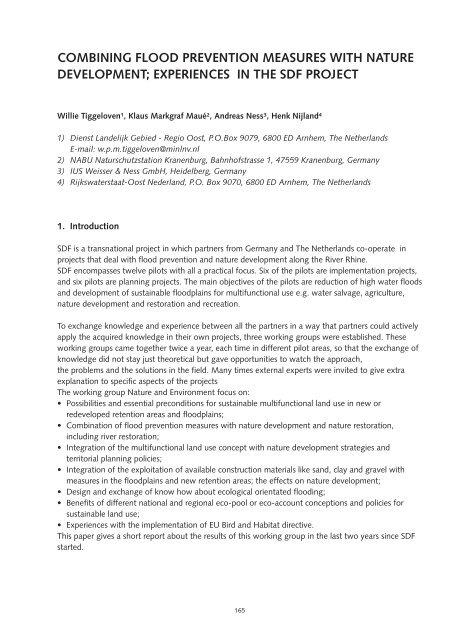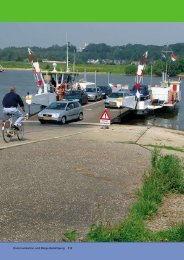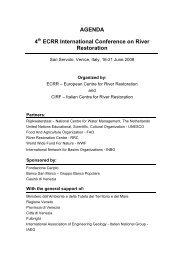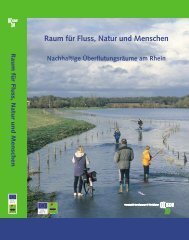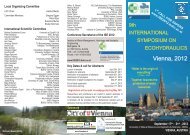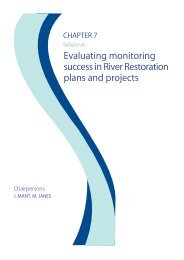multifunctional land use - European Centre for River Restoration
multifunctional land use - European Centre for River Restoration
multifunctional land use - European Centre for River Restoration
You also want an ePaper? Increase the reach of your titles
YUMPU automatically turns print PDFs into web optimized ePapers that Google loves.
COMBINING FLOOD PREVENTION MEASURES WITH NATURE<br />
DEVELOPMENT; EXPERIENCES IN THE SDF PROJECT<br />
Willie Tiggeloven 1 , Klaus Markgraf Maué 2 , Andreas Ness 3 , Henk Nij<strong>land</strong> 4<br />
1) Dienst Landelijk Gebied - Regio Oost, P.O.Box 9079, 6800 ED Arnhem, The Nether<strong>land</strong>s<br />
E-mail: w.p.m.tiggeloven@minlnv.nl<br />
2) NABU Naturschutzstation Kranenburg, Bahnhofstrasse 1, 47559 Kranenburg, Germany<br />
3) IUS Weisser & Ness GmbH, Heidelberg, Germany<br />
4) Rijkswaterstaat-Oost Neder<strong>land</strong>, P.O. Box 9070, 6800 ED Arnhem, The Nether<strong>land</strong>s<br />
1. Introduction<br />
SDF is a transnational project in which partners from Germany and The Nether<strong>land</strong>s co-operate in<br />
projects that deal with flood prevention and nature development along the <strong>River</strong> Rhine.<br />
SDF encompasses twelve pilots with all a practical focus. Six of the pilots are implementation projects,<br />
and six pilots are planning projects. The main objectives of the pilots are reduction of high water floods<br />
and development of sustainable floodplains <strong>for</strong> <strong>multifunctional</strong> <strong>use</strong> e.g. water salvage, agriculture,<br />
nature development and restoration and recreation.<br />
To exchange knowledge and experience between all the partners in a way that partners could actively<br />
apply the acquired knowledge in their own projects, three working groups were established. These<br />
working groups came together twice a year, each time in different pilot areas, so that the exchange of<br />
knowledge did not stay just theoretical but gave opportunities to watch the approach,<br />
the problems and the solutions in the field. Many times external experts were invited to give extra<br />
explanation to specific aspects of the projects<br />
The working group Nature and Environment focus on:<br />
• Possibilities and essential preconditions <strong>for</strong> sustainable <strong>multifunctional</strong> <strong>land</strong> <strong>use</strong> in new or<br />
redeveloped retention areas and floodplains;<br />
• Combination of flood prevention measures with nature development and nature restoration,<br />
including river restoration;<br />
• Integration of the <strong>multifunctional</strong> <strong>land</strong> <strong>use</strong> concept with nature development strategies and<br />
territorial planning policies;<br />
• Integration of the exploitation of available construction materials like sand, clay and gravel with<br />
measures in the floodplains and new retention areas; the effects on nature development;<br />
• Design and exchange of know how about ecological orientated flooding;<br />
• Benefits of different national and regional eco-pool or eco-account conceptions and policies <strong>for</strong><br />
sustainable <strong>land</strong> <strong>use</strong>;<br />
• Experiences with the implementation of EU Bird and Habitat directive.<br />
This paper gives a short report about the results of this working group in the last two years since SDF<br />
started.<br />
165


